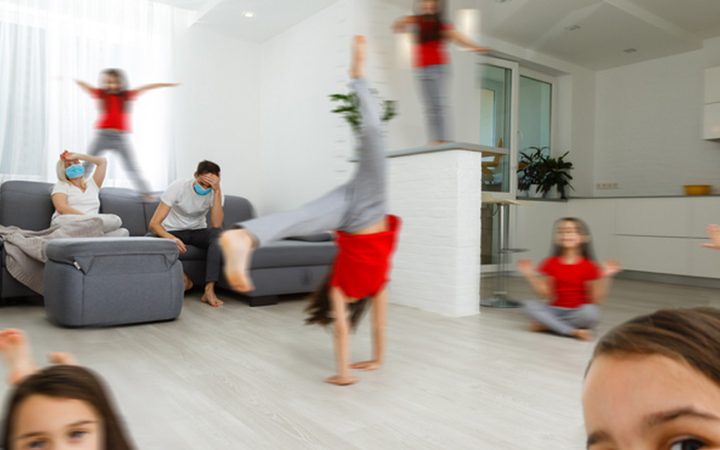Anxiety refers to a feeling of nervousness or uneasiness about a situation or outcome (1). All children experience anxiety at some point. However, children with an anxiety disorder may experience extreme worry and fear, affecting their daily functioning. They may also fail to outgrow the fears or worries common in early childhood.
Encouraging children with anxiety to practice healthy habits and engage in activities is crucial to help them manage and overcome their anxiety (2).
Read this post as we have put together a list of activities you can perform with your child.
15 Activities For Children With Anxiety
1. Mind jars
The calming glitter jar, also called the mind jar, is a fun craft project that you can do with your child. It is a tried-and-true mindfulness project known to aid relaxation (3). The goal is for your child to use this jar on their own when they experience anxiety. The calming jar activity helps children relax, focus, and realize that paying attention to their senses can lessen their anxiety.
Add glitter glue in a major jar filled with warm water and mix well. Remember, the warmer the water, the easier it is to dissolve the glitter without clumps. Add food coloring and sequins to make the mixture more vibrant and sparkling. Fill the jar with warm water up to the brim. Finally, make sure the caps of the bottles are glued on properly to avoid spills.
2. Relaxation stones
Create small and smooth relaxation stones with oven-baked clay. You may add a thumb-shaped indentation to each to help your child relax while rubbing their fingers on it.
You can also collect stones of different shapes and sizes, paint them, and write short, positive messages or quotes on them.
3. Giant bubbles
Activities that involve deep breathing have a calming effect on the nervous system and the brain (4). For example, blowing bubbles requires deep breathing and is thus helpful for children with anxiety.
Make a mixture of soap and water and store it in a container. Then, let your child blow as many bubbles as they can using a bubble blower. You can also make this activity more interesting by making your child blow bubbles over their head while lying on the ground on their back. Let them observe the bubble as they reach the ground gradually.
4. Painting
Research has proven that engaging in creative activities, such as painting or other art forms, is beneficial for children with anxiety (5). Creating art also helps children direct all their attention and focus in the present moment.
5. Superhero
Children are highly influenced by superheroes and the powers they possess. Let your child imagine themselves to be a superhero. Ask them about the superpowers and strengths they wish to possess, and try some of these amazing superhero activities for kids to help them relax or keep them engaged.
6. Anxiety companion
Give your children a toy or pet to help them face their worries and anxieties. A worry or anxiety companion is an object or pet your child can talk to and share their feelings with when anxious. Encourage them to talk about what might be bothering them, why it is bothering them, and how they want to feel. The friendly and comforting companion can help put your child’s mind at ease (6).
7. Instant comfort or anxiety coping boxes
Make a box for your child containing chits with positive messages or quotes that can be an instant source of motivation when they feel anxious and you are not around them to comfort them. These messages can be written either by you or your child.
8. Collage
Give your children magazines containing colorful, bright pictures and ask them to make a collage with the pictures they find calming. Making a collage can help them forget about their worries and release stress. Besides, it does not require complex artistic skills, and your child can express themselves freely.
9. Stress balls
Stress balls have always been a go-to remedy for tackling stress and anxiety. You can either make DIY stress balls at home with your child or get one from the market. Squeezing a stress ball stimulates the nerves and muscles and improves the overall nervous system, thus reducing cortisol, the main stress hormone (7).
10. Bibliotherapy
Bibliotherapy, also referred to as book therapy or therapeutic storytelling, is the process in which you read a story or certain parts of a story to your child with the purpose of healing or making them feel calm (8). Read a storybook to your child and help them relate to the characters in the story.
11. Journaling
Maintaining a journal allows your child to find an outlet for all the emotions and feelings they may be unable to express. So, gift your child a journal and let them write whatever they feel. It will help them validate their feelings and fears, understand the stressors, and control or manage those stressors (9).
12. 5-4-3-2-1 sensory activity
This is a simple yet effective activity you can introduce to your child as it is known to help regain calm and composure when moments of anxiety hit them.
Ask your child to look around their surroundings and search for five things they can touch, four things they can see, three things they can hear, two things they can smell, and one thing they can taste. This will help them distract their minds from the anxiety and also make them feel better. Besides, the activity is also perfect for teaching young children about the five senses.
13. Happy brain, worry brain
This activity will help you understand your child’s weaknesses and strengths and develop their coping skills.
Take two pieces of paper. Label one of them as ‘Happy Brain’ and the other as ‘Worry Brain.’ Now let your child fill them in with the thoughts or feelings that might fit into each category.
14. Worry escape corner or room
Identify a cozy corner or room in your house where your child usually likes to sit or play. Decorate the area with a cozy blanket, cushions, and lights, and keep your child’s favorite things around it. This will act as a safe space for your child when they feel anxious.
15. Calm down toolbox
Put numerous things in a calm-down toolbox for your child and personalize it according to their needs and requirements. For example, you can put relaxation stones, a stress ball, a journal, and a few other items to help your child when they have anxiety.
The best way to assist children in overcoming their anxiety isn’t to remove the circumstances that cause it but to help them manage and cope with their anxiety. Try any of the activities that you think would help your child feel relaxed.
References:
MomJunction’s health articles are written after analyzing various scientific reports and assertions from expert authors and institutions. Our references (citations) consist of resources established by authorities in their respective fields. You can learn more about the authenticity of the information we present in our editorial policy.



































